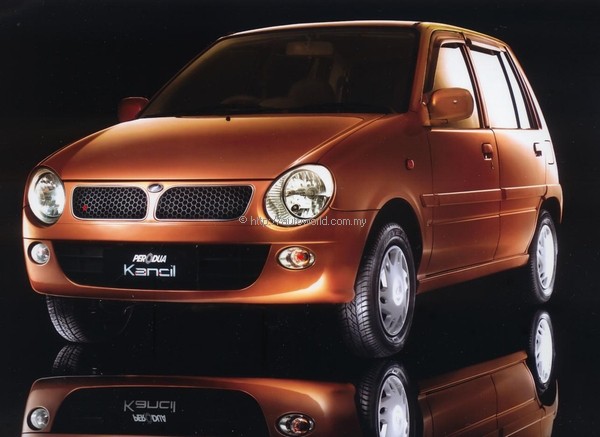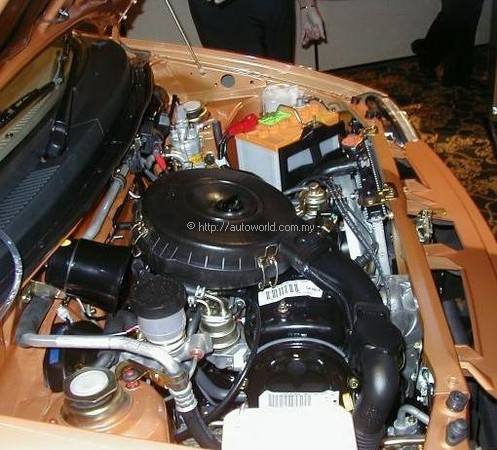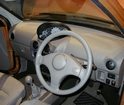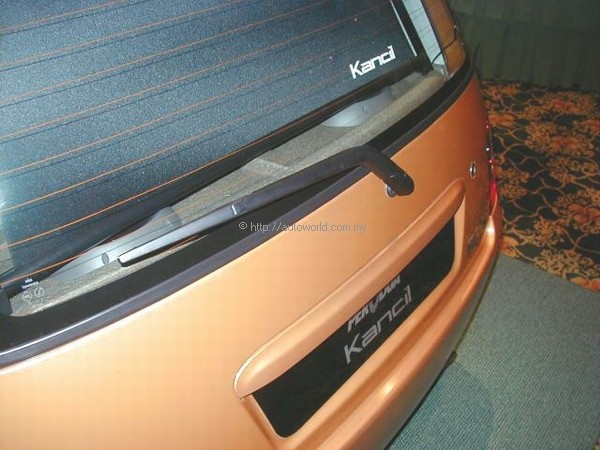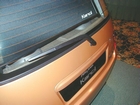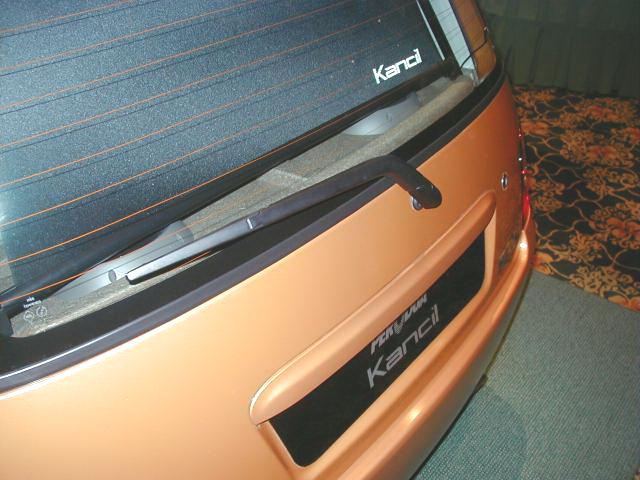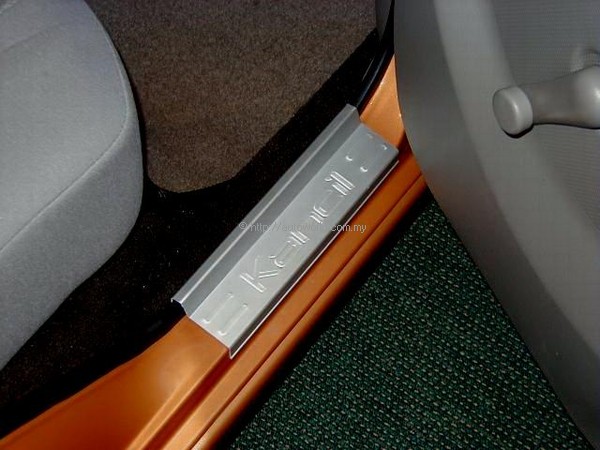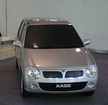The New Perodua Kancil – UPDATED STORY
On Thursday, AUTOWORLD.COM.MY brought you the first detailed description of the new Perodua Kancil. Tonight, following the launch of the model at Dataran Merdeka in Kuala Lumpur, we bring you the first complete set of pictures. Our story is updated in some areas and if you have read the earlier one, then just go to the sections in BOLD which contain updated information, especially on the 850 cc EFI engine which will be available in early 2003. Full specifications are also available and the links are at the bottom of the page.
By the end of 2002, Perodua expects that some 472,500 Kancils will have been produced. Put all these bumper to bumper and they would stretch from the northernmost point of Peninsula Malaysia to the Causeway to Singapore. That’s a lot of Kancils and the fact underlines the success of the model which arrived on Malaysian roads in August 1994.
Until the Kancil came along, the minicar segment was an undeveloped one; other than Suzuki which made an effort with the 800 cc SS80 Fronte in the late 1990s (the Daihatsu Charade was one notch above the minicar category), no one was interested in this segment.
Then along came Perodua, with its technical partner and shareholder, Daihatsu Motor, which saw a niche in the minicar segment and offered the Kancil with a 660 cc – later to be joined by a 850 cc variant – as a low-cost, highly affordable car. Its price made it possible for many to get a brand new car as the first car in their life, while those who were riding motorcycles could also afford make the switch to four wheels, with the added comfort of a ‘roof over their heads’ on rainy days.
The arrival of Perodua as a second national make was scorned by some but forward-looking executives welcomed the entry-level models it sold. A senior executive in Toyota (Daihatsu is today part of the Toyota Group) had this to say in 1995 when asked about the Perodua Kancil’s introduction: “It is certainly good to have such a low-priced model as an entry-level car because it will help convert many Malaysians from motorcycles to cars. In the longer term, the market size will grow and this will be good for everyone else because they will obviously continue to upgrade to bigger cars like our Toyota Corolla!”
And indeed, the Kancil has done just that… besides adding more cars to the roads and also contributing to congestion! The success of the ‘conversion’ was apparent from the experience of one company regarding its parking spaces. During the recession of the 1980s, the company had retrenched many staff and it was expected that parking would be less of a problem because of less people, hence less cars, in the company. Yet, by the mid-1990s, in spite of a smaller workforce, there was a parking problem in the same compound! A study revealed an interesting thing: before, the more junior staff and office boys came to work on motorcycles or used buses, now they were coming by their own cars… typically the Kancil!
448,000 Kancils later, the first Perodua model gets its most significant change in its 8-year history. While there have been two facelifts previously (in 1997 and 1999), they have been minor compared to what has been done this time. The new styling uses elements of the silver XA02 prototype which some of you may remember were circulated on the Net some time ago. It was done prior to the recession as a next-generation Kancil but the project was shelved for various reasons when the recession hit. According to sources, the design involved not just cosmetics but also re-engineering of the platform to make it slightly bigger.
After the recession and with Daihatsu coming in with a greater role, the product plan changed and the XA02 concept was not such a good idea. Instead, the existing Kancil platform would be improved and given a fresh new look for 2002, with a view of keeping it in production till 2006.
The styling of the new Kancil is refreshing and certainly an excellent job done. What is even more impressive is that the whole styling effort was done in-house by Malaysians. For those who have long been critical of the ability of Malaysians to do car styling, the new Kancil’s looks should make them think again. This creative talent was developed through having stylists do a stint at a design house in Italy as well as a concept car exercise with a company in Australia. And in our view, it is one of the finer examples of the Malaysia Boleh spirit.
The first thing that you will notice is that the bumpers are ‘gone’. The whole front end is flush now and the radiator grille has been redesigned to a smarter appearance with a honeycomb mesh in the two openings that are integral to the ‘corporate face’ of Perodua’s products. It’s a sporty look and also classy in its own way.
The headlights are also new and if you know what a Sirion looks like, you’ll have an idea of how the oval units are. Because the bonnet and side panels have been redesigned with a more curves, the oval shapes jive well with the overall looks, something which would not have been achieved if the previous, more straight lines were retained. Even the treatment of the signal lamps, integrated in the bumper, has been done in a unique and attractive manner.
The side profile remains recognizable as a Kancil and the doors are identical to those used before. It is likely that one of the reasons why the designers didn’t touch the doors is that the door openings are critical areas in a car’s structure and have been carefully computer-designed and tested. Altering these would mean additional engineering work and extra cost, both of which may have been considered unnecessary.
The whole rear hatch is new and there is even a new and larger wiper fitted as standard. It looks like a fairly solid unit with a thick arm and black finish. The rear glass appears to wrap around and seems larger but it’s actually some clever ‘black-out’ treatment around the edges to create that look. The rear light units are brand new and follow the latest trends of having a jewel-like appearance. And like the front, the rear bumper is also flush with the bodywork.
A new and trendy colour, Kosmik Orange (the car shown in the pictures) is available for the new Kancil 850 EX. For the 660EX, there are three colours available (White, Red and Silver) while the 850 EX has the new colour plus another four (White, Gold, Silver and Blue).
Inside, the cabin has been totally redesigned and though the car’s dimensions are unchanged, the visual appearance is of more space. This seems to be due to the use of new trim colours and new fabrics that also have a nicer, higher-quality feel. The door panels are now monolithic units, ie moulded as a single piece.
Sitting behind the steering 3-spoke wheel, you’ll notice something odd… the instrument panel is gone! In the complete redesign of the dashboard module, the instrument panel has been moved to the middle part, just like the Hyundai Matrix and Toyota Prius and Yaris. Unlike some of the others though, the one in the new Kancil is slanted a bit towards the driver for easier viewing.
The position may seem odd at first but ergonomic studies have shown that it is actually easier to view due to the way the eyes focus. It allows the driver’s eyes to remain in the right focus for the road ahead, while also making the meters legible. This is especially good for older drivers whose eyesight has deteriorated. For shorter drivers too, the absence of the meter shroud directly ahead of them should help forward visibility!
Other noticeable changes on the dashboard include the vent flaps and a rather strange-looking gear knob which is a bit over-sized. Maybe it’s better for gripping but we’ll see when we test the car later on… On the 850 EX and EZi Kancils, there are also power windows and door mirrors while for all new versions, the seats have been restructured for better support.
But there are still no rear seatbelts fitted as standard, an issue which Perodua has promised to address as quickly as possible in view of the fact that Kancil owners could get arrested for not having rear seatbelts for their passengers when they drive into Singapore! That country now has a regulation which makes it compulsory for rear occupants to be belted up as well.
“Thus far, we have omitted rear seatbelts for the Kancil because our surveys have shown that most people do not seem to use it. By leaving it out, there is a slight saving in cost for us. However, taking note of the comments in the Autoworld.com.my forum and also comments from other owners, we can see that there is a growing shift in attitudes towards safety features and we will certainly look into this matter now,” promised Zainuddin Bahaudin, Executive Director of Perodua Sales Sdn Bhd.
Mechanically, the new Kancil is pretty much the same as before although there will certainly be new materials and new components here and there. The safety aspect of the design has been fully tested by Daihatsu in crash tests and meets the required standards.
The trusty fuel-sipping 3-cylinder 660 cc engine is unchanged and still has a carburetor and no catalytic converter and is mated to a 5-speed manual transmission. The bigger 850 cc engine is also unchanged but will only be used for the manual transmission Kancil; by December, Perodua will begin manufacturing the new 850 cc ED-DE engine with EFI and this will be exclusively used for the 850 EZi Automatic. The launch date for the Kancil EZi is likely to be early next year.
“The new ED-DE engine will be an upgraded one with EFI and its output will be significantly higher. However, because of Daihatsu’s thorough testing procedures and due to the fact that the engine is made locally with many local components, its production has to be delayed a few months,” revealed Perodua MD Tan Sri Datuk Abdul Rahman Omar. He added that the same 850 cc engine will also be fitted to the Kelisa next year, so it must be pretty powerful. It is also tuned for a higher emission control standard of ‘Step 3’, which is one step ahead of present regulations and already introduced in Singapore and Hongkong.
According to advance information which AUTOWORLD.COM.MY obtained, the new ED-DE engine will have an impressive increase in power from the present ED-10 engine. With a higher compression ratio, an extra camshaft and EFI, its power output will go to 36.7 kW (50 bhp) at 5200 rpm, an increase of 33.5%. Torque will peak at 4000 rpm – 200 rpm higher than the present 850 cc engine – and will be a maximum of 74.4 Nm or almost 19% more.
Considering that the weight increase will be only about 2%, this will make the new Kancil EZi quite a quick machine and it is not surprising that Perodua wants to use the same engine for a lower-priced Kelisa as well.
Buyers of the new Kancil, and other new Perodua models, can also expect increasingly higher quality in the products. According to the Perodua MD, just two years ago, the QC rate was around 15 defects per car (‘defects’ here means even little spots on the paintwork, some of which the average motorist may not even notice). The increased involvement of Daihatsu has seen this figure fall quickly to an average of 1.3 defects per car today and the target by 2006 is 0.5 defects/car. This target is the same as what Daihatsu sets for its own factories in Japan. By comparison, Toyota’s defect rate is set at 0.05 per car.
The increased quality is evident in the new Kancil where the gaps between panels are tight, and alignment of different parts is straight. And as many owners will already know, the paintwork is top-notch, hardly surprising as Perodua’s paintshop is a pretty advanced one.
As mentioned earlier, the Kancil’s production life is presently planned to run till 2006, by which time it will be 12 years old (so it’s not going to be in contention for the title as the ‘longest-running national car model’!).
“If there is no change in the economic growth and no other valid reason to keep it in production, we plan to have the Kelisa take over as the entry-level model,” said Tan Sri Abdul Rahman. “That cannot happen now because the Kelisa’s pricing is still high, so we need a while more.”
Bringing the Kelisa’s price down will be part of Perodua’s short-term goal of ‘Towards 333’ by 2006. The “three 3s” refer to a 30% domestic market share in the AFTA era; a reduction of production costs by 30%; and elevation to being among the Top Three in the Customer Satisfaction Index (currently, Toyota, Honda and Nissan are in the top positions locally).
As already known by now, prices of the new Kancil 660 EX and 850 EX are RM200 cheaper than the models the replace. To our knowledge, this is the first time that a model offered locally has been launched at a price lower than the model it replaces. That’s pretty impressive and a clear sign that Perodua has been able to lower its production costs significantly enough that it can pass on the savings to buyers. This is the sort of thing that Malaysians will surely appreciate of their national carmaker and provide enough reason to support Perodua.
As for the Kancil EZi which only goes on sale next year, no prices have been mentioned and it would not be a good idea to assume Perodua will do the same price reduction. Unlike the present engines, the new ED-DE engine has been re-engineered and EFI has also been added. So its cost could be high in the initial years and therefore Perodua may not be able to offer it cheaply as well. That the company wants to also put it in the Kelisa is an indication that it wants to boost the volume as quickly as possible for that engine so as to achieve economies of scale faster, and in so doing, bring the cost of making it down.



